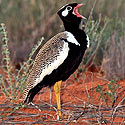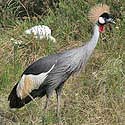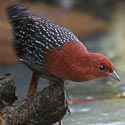|
Order: Gruiformes (cranes, rails,
crakes, flufftails, gallinules, moorhens, coots, finfoots, bustards, korhaans)
Life
> Eukaryotes >
Opisthokonta
> Metazoa (animals) >
Bilateria >
Deuterostomia > Chordata >
Craniata > Vertebrata (vertebrates) > Gnathostomata (jawed
vertebrates) > Teleostomi (teleost fish) > Osteichthyes (bony fish) > Class:
Sarcopterygii (lobe-finned
fish) > Stegocephalia (terrestrial
vertebrates) > Tetrapoda
(four-legged vertebrates) > Reptiliomorpha > Amniota >
Reptilia (reptiles) >
Romeriida > Diapsida > Archosauromorpha > Archosauria >
Dinosauria
(dinosaurs) > Saurischia > Theropoda (bipedal predatory dinosaurs) >
Coelurosauria > Maniraptora > Aves
(birds)
Families indigenous to southern Africa
|
Otididae (bustards and
korhaans) Bustards and korhaans are found in open to
lightly wooded habitats, and are found in many dry areas in southern Africa.
They are omnivorous, feeding on a range of plant products and small animals,
especially insects. Most species are polygynous, with the female solely
incubating the eggs, and often caring for the chicks, although in the
Eupodotis genus, the male participates as well. It lays 1-3, very rarely
6 eggs directly on the ground, often with enough surrounding vegetation to
conceal the incubating female. |
 |
|
Gruidae (cranes)
Cranes can be found in many areas of southern Africa, and occur in a variety
of habitats, although they are usually associated with marshes and wetlands,
their preferred breeding place. They are omnivorous, feeding on a wide
variety of plants and animals. They |
 |
|
Heliornithidae (finfoots) Only one
species in southern Africa,
Podica senegalensis (African
finfoot). |
 |
|
Rallidae (rails, crakes,
flufftails,
gallinules, moorhens and coots) |

|
|
